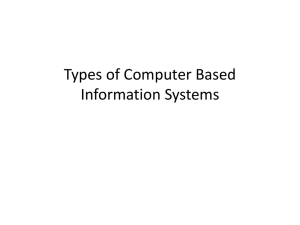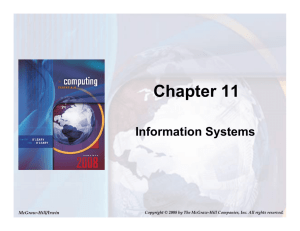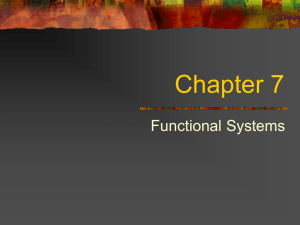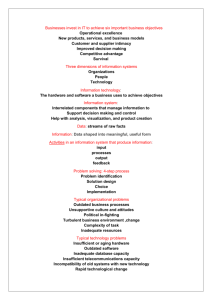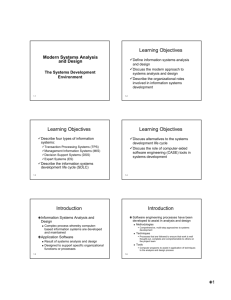Management Information Systems CHAPTER OUTLINE LEARNING
advertisement
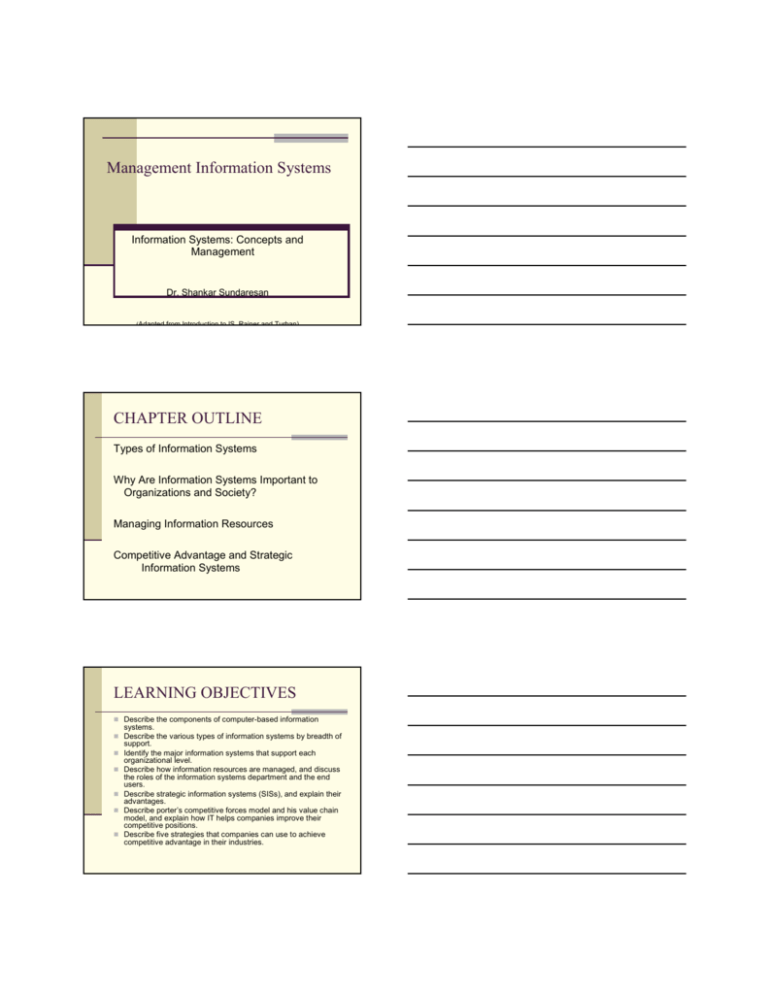
Management Information Systems Information Systems: Concepts and Management Dr. Shankar Sundaresan (Adapted from Introduction to IS, Rainer and Turban) CHAPTER OUTLINE Types of Information Systems Why Are Information Systems Important to Organizations and Society? Managing Information Resources Competitive Advantage and Strategic Information Systems LEARNING OBJECTIVES Describe the components of computer-based information systems. Describe the various types of information systems by breadth of support. Identify the major information systems that support each organizational level. Describe how information resources are managed, and discuss the roles of the information systems department and the end users. Describe strategic information systems (SISs), and explain their advantages. Describe porter’s competitive forces model and his value chain model, and explain how IT helps companies improve their competitive positions. Describe five strategies that companies can use to achieve competitive advantage in their industries. Information System An information system (IS) collects, processes, stores, analyzes, and disseminates information for a specific purpose. Like any other system, an information system includes inputs (data, instructions) and outputs (reports, calculations). It processes the inputs by using technology such as PCs and produces outputs that are sent to users or to other systems via electronic networks and a feedback mechanism that controls the operation. Information System Is A System Information Systems Information System (IS). Collects, processes, stores, analyzes and disseminates information for a specific purpose. Computer-based Information System (CBIS). An information system that uses computer technology to perform some or all of its intended tasks. Information System Concepts and Definitions An information system (IS) collects, processes, stores, analyzes, and disseminates information for a specific purpose “Application”. Hardware Software Data Network Procedures People Information Technology Narrowly, collection of computer systems used by an organization (subset of IS) synonymous with IS Broadly, organization’s collection of IS, users, Management Hardware Software Application Data People Basic Components of Information Systems Hardware is a device such as a processor, monitor, keyboard or printer Software is a program or collection of programs that enable hardware to process data. Database is a collection of related files or tables containing data. Network is a connecting system (wireline or wireless) that permits different computers to share resources. Procedures are the set of instructions about how to combine the above components in order to process information and generate the desired output. People are those individuals who use the hardware and software, interface with it, or uses its output. Application program is a computer program designed to support a specific task , a business process or another application program. Breadth of Support of Information Systems Functional area information systems support particular functional areas in an organization. Enterprise resource planning systems tightly integrate the functional area information systems via a common database. Transaction processing systems support the monitoring, collection, storage, and processing of data from the organization’s basic business transactions. Interorganizational information systems connect two or more organizations. Examples are supply chain management systems and electronic commerce systems. Information Systems Support for Organization Employees Office automation systems Functional area information systems Business intelligence systems Expert Systems Dashboards support all managers by providing rapid access to timely information and direct access to structured information in the form of reports. Information Systems Inside Your Organization Classification of Information Systems Detailed classification Information Systems Classification By Organizational Structure An information system (IS) can span departments, business units and corporations. PC PC U nix Enterprise S erver PC Hub Departmental IS S erial Terminals Enterprise-Wide IS In-house operations Thin Client Mux Inter-Organizational IS Thin Client DIALUP/T1/T3/ISDN/FR AME RELAY DIALU P/T1 /T3/ISDN /FRAME R ELAY Mux Information systems are usually connected by means of electronic networks Thin Client PC Mux Thin Client Appliance Unix Enterprise S erver Appliance Server Store 3 PC Appliance Appliance Server S tore 3 On-line Multi-station Store Store Locati on 1 On-line Multi-station Store Store Location 2 Information Systems Classification By Function (Department) An information system (IS) support each department in a corporation. Operations Accounting Finance Marketing Human resources Transaction Processing Systems (TPS): Automates routine and repetitive tasks that are critical to the operation of the organization Routine Transactions & Functional Examples Payroll Employee Time cards Employee payroll an deductions Payroll checks Benefits Purchase Purchase orders Deliveries Payments (accounts payable) Finance and Accounting Financial statements Tax records Expense Accounts Sales Sales records Invoice and billings Accounts receivable Sales returns Shipping Production Production planning and reports Quality control reports Information Systems Classification By Support Function Executive Support System Senior Mgr Management Information System Decision Support System Middle Managers Intelligent Support Systems Knowledge Management System Office Automation System Data Workers Transaction Processing System Operational Managers Transaction Processing System (TPS) TPS automates routine and repetitive tasks that are critical to the operation of the organization Examples: preparing a payroll, billing customers, Point-of-Sale and Warehouse operations Data collected from this operation supports the MIS and DSS systems employed by Middle Management Computerizes the primary and most of the secondary activities on the Value Chain. Primary purpose to perform transactions and collect data. Management Information Systems (MIS) These systems access, organize, summarize, and displayed information for supporting routine decision making in the functional areas. Geared toward middle managers Characterized mainly by their ability to produce periodic reports such as a daily list of employees and the hours they work, or a monthly report of expenses as compared to a budget Typical uses statistical summaries, exception reports, periodic reports, projections, forecasting, routine decision automation Examples: Pricing analysis, sales management Decisions supported are more structured. Primary purpose to process data into information Decision Support Systems (DSS) These systems support complex non-routine decisions. Primary purpose to process data into information Typically employed by tactical level management whose decisions and what-if analysis are less structured. This information system not only presents the results but also expands the information with alternatives. Some DSS methodologies Mathematical Modeling Simulation Queries What-If (OLAP-Cubes) Intelligent Support Systems (ISS) Essentially, artificial intelligence (AI) these systems perform intelligent problem solving. Expert Systems (ES) – Use of AI Expert systems (ESs) provide the stored knowledge of experts to non- experts, so the latter can solve difficult or time-consuming problems. These advisory systems differ from TPS which centered on data differ from MIS and DSS, which concentrate on processing information With DSS, users make their decisions according to the information generated from the systems. With ES, the system makes recommended decisions for the users based on the built-in expertise and knowledge. Executive Support Systems (ESS) ESS systems or Enterprise Information Systems (EIS) originally were implemented to support Senior management. These systems have been expanded to support other managers within the enterprise. At the senior management level they support Strategic activities which deal with situations that significantly may change the manner in which business is done. Office Automation Systems (OAS) Electronic communication is only one aspect of what is now known as an office automation system (OAS). Other aspects include word processing systems, document management systems and desktop publishing systems. OAS systems are predominantly used by clerical workers who support managers at all levels. Among clerical workers, those who use, manipulate, or disseminate information are referred to as data workers. Knowledge Management Systems (KMS) Supports the creation, storage, and dissemination of knowledge in organization Supports knowledge workers An additional level of staff support now exists between top and middle management. These are professionals, such as financial and marketing analysts that act as advisors and assistants to both top and middle management. Often, they develop new knowledge (External Content) for the organization and integrate it with existing knowledge (Internal Content). KMS that support these knowledge workers range from Internet search engines and expert systems, to Web-based computer-aided design and sophisticated data management systems Example Systems Sales Management Inventory Control Annual budget Production Scheduling Cost Analysis Pricing Analysis Simulation Program coding System support Word Processing Desktop Publishing Order Processing Fulfillment Material Movement A/R, A/P, GL Payroll POS 5-year sales trend Profit Planning 5-year budget forecasting Product development Information Technology Outside Your Organization Expand our Scope to Include External Environments & IT Support A supply chain is a concept describing the flow of materials, information, money, and services from raw material suppliers through factories and warehouses to the end customers. Components of the Supply Chain Upstream supply chain Internal supply chain includes the organization’s first-tier suppliers and their suppliers IT Support – e-procurement, supplier portal includes all the processes used by an organization in transforming the inputs of the suppliers to outputs Downstream supply chain includes all the processes involved in delivering the products to final customers IT support: call center, order taking, CRM Inter-Organizational Systems (IOS) IOS are systems that connect two or more organizations. These systems are common among business partners and play a major role in e-commerce, as well as in supply chain management support. Electronic Data Interchange (EDI) The first type of IT system that was developed in the 1980s to improve communications with business partners involves computer-to-computer direct communication of standard business documents (such as purchase orders and order confirmations) between business partners. Electronic Market and Electronic Commerce Web-based systems These systems (many using XML) deliver business applications via the Internet. Using browsers and the Internet, people in different organizations communicate, collaborate, access vast amounts of information, and run many organizational system Why are Information Systems Important to Organizations & Society IT will reduce the number of middle managers. IT will change the manager’s job. IT impacts employees at work. IT provides quality-of-life improvements. Managing Information Resources Which IT Resources are Managed and By Whom? During the early 1950s, Information Systems Department (ISD) managed ALL of the only computing resource, the mainframe. Today, computing resources are located through the organization and almost all employees use computers in their work. This system is known as end user computing. The Role of the IS Department The ISD is responsible for corporate-level and shared resources and for using IT to solve end users’ business problems. End users are responsible for their own computing resources and departmental resources. ISD and end users work together as partners to manage the IT resources. Traditional Major IS Functions Managing systems development and systems project management Managing computer operations Staffing, training, developing IS skills Providing technical services Infrastructure planning, development, control New (Consultative) IS Functions Initiating and designing strategic information systems Incorporating the Internet and e-commerce into the business Managing system integration Educating non-IS managers about IT Educating IS staff about the business Supporting end-user computing Partnering with executives Managing outsourcing Innovate Ally with vendors and IS departments in other organizations fig_02_01 fig_02_02 fig_02_03 table_02_01 table_02_02
